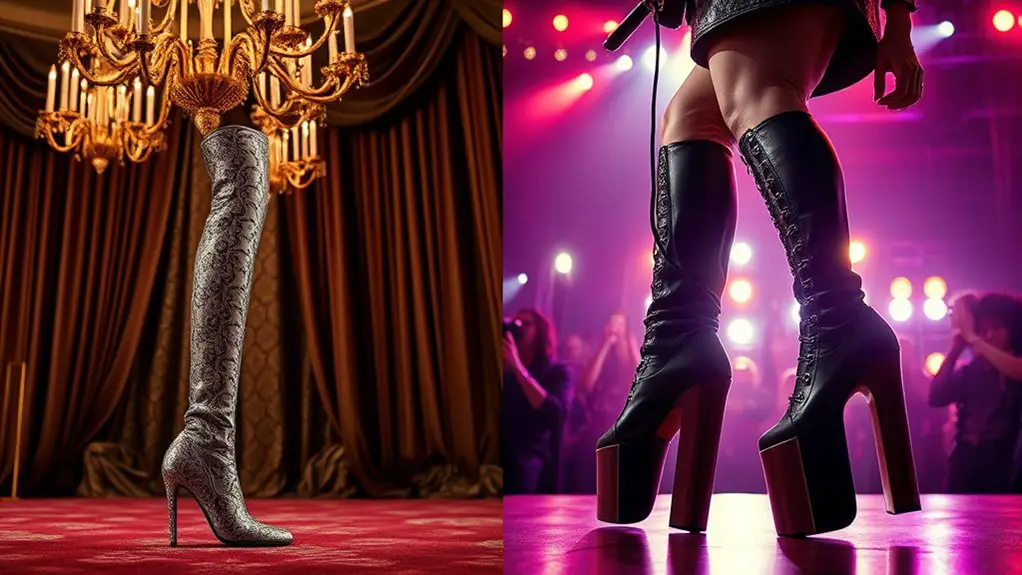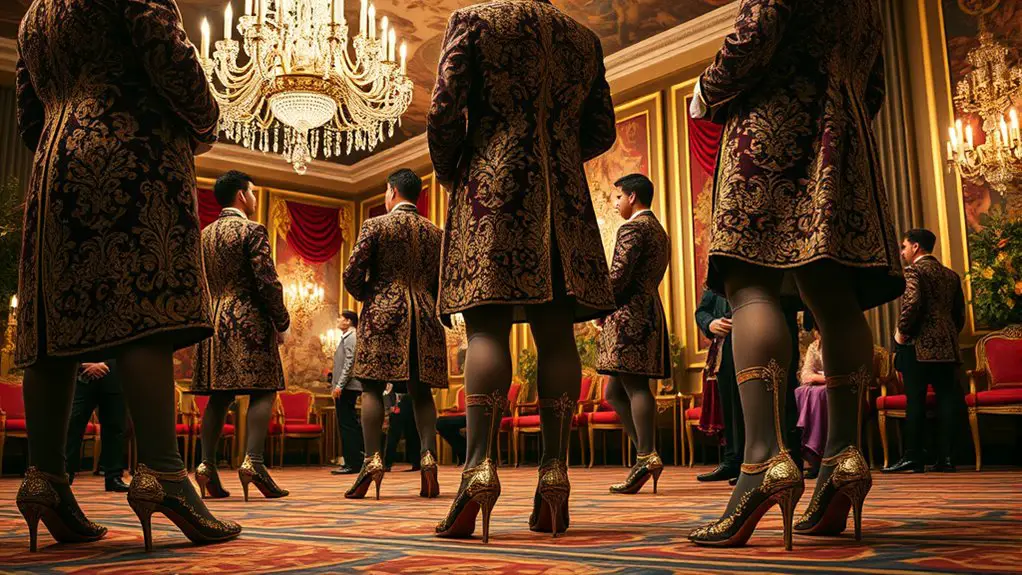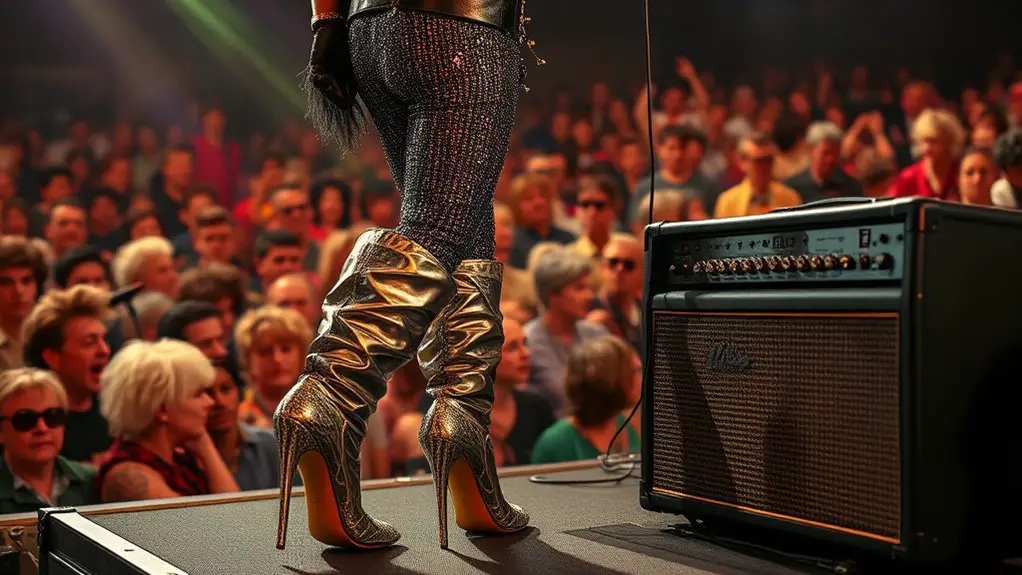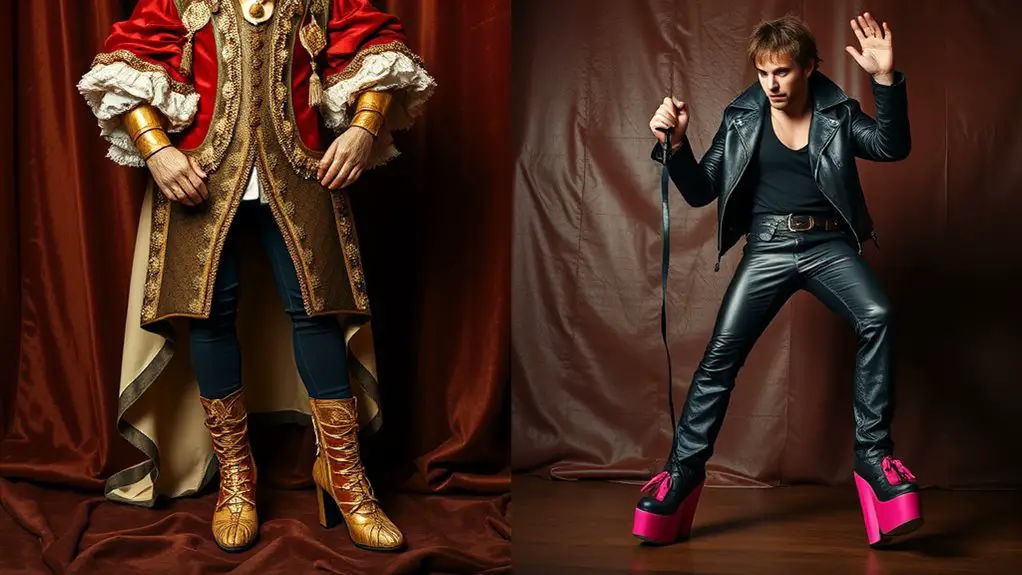Men’s heels have evolved considerably over the centuries. Initially worn by kings to assert power, they shifted towards feminine fashion by the 18th century. As societal norms transformed, heels declined in the 19th century, representing a more rugged masculinity. However, the rock and roll era reignited their popularity as icons like David Bowie embraced them, challenging traditional gender roles. Today, heels symbolize fluidity in fashion, inviting men to express themselves boldly. Explore how this journey continues to shape modern style.
The Origins of Heels: Aristocracy and Authority

Although many associate high heels with modern fashion, their origins trace back to the aristocracy of the 16th and 17th centuries, where they were symbols of power and status. During this era, men of noble birth wore heels as part of their aristocratic fashion, elevating their stature—both literally and figuratively. The elevated heel not only added height but also conveyed strength, authority, and wealth.
Worn by kings and courtiers alike, these shoes became essential in demonstrating one’s social standing. The elaborate craftsmanship and luxurious materials used in their creation further emphasized their role as power symbols. As you explore this fascinating history, you’ll notice how heels represented more than mere aesthetic choices; they were integral to the identity and hierarchy of the aristocracy. Understanding these roots enriches your perception of heels, revealing a complex interplay of fashion, power, and societal norms that continues to evolve today.
The Transition: From Male Dominance to Feminine Fashion
As the 18th century progressed, a notable shift occurred in the fashion landscape, marking the change of heels from symbols of male dominance to staples of feminine attire. This change greatly altered cultural perceptions, reshaping the masculine identity and its associations with power and authority.
| Masculine Identity | Feminine Fashion |
|---|---|
| Authority and control | Elegance and allure |
| Strength and dominance | Softness and beauty |
| Utilitarian purpose | Expressive style |
| Social status | Individual expression |
The rise of women in heels indicated a broader cultural evolution, where femininity began to embrace elegance traditionally reserved for masculinity. This not only redefined footwear but also challenged societal norms, allowing women to reclaim space in fashion. As societal roles evolved, so did the importance of heels, reflecting a complex interplay between gender and style.
The Baroque Era: Heels as Symbols of Status

During the Baroque Era, which spanned from the late 16th to the early 18th century, heels became a powerful emblem of social status and prestige. Their significance wasn’t merely about footwear; it reflected the intricate dynamics of power and social hierarchy.
Consider these key aspects:
Key aspects of Baroque heels reveal their role as symbols of power, prestige, and the intricate dynamics of social hierarchy.
- Ornate Designs: Heels featured elaborate embellishments, showcasing craftsmanship and wealth.
- Royal Imagery: Kings and nobles donned extravagant styles, reinforcing their dominance in society.
- Cultural Significance: Heels symbolized not just fashion but also the shifting power dynamics of the time.
In a world where Baroque fashion emphasized grandeur, men’s heels served as status symbols, elevating one’s position in the eyes of peers. The heightened stature and dramatic flair of heels embodied the essence of an era obsessed with opulence and royal imagery, marking a distinct separation between the elite and the common populace.
The 19th Century: The Decline of Men’s Heels
By the 19th century, fashion norms were shifting dramatically, leading to the decline of men’s heels. As ideals of masculinity evolved, practicality and a more austere aesthetic took precedence over flamboyant styles. This transformation not only reflected societal changes but also redefined what it meant to be a man in a rapidly industrializing world.
Changing Fashion Norms
While the 19th century heralded the rise of industrialization and changing social norms, it also marked a significant decline in men’s fashion, particularly in the domain of footwear. As societal perceptions evolved, men’s heels gradually fell out of favor, influenced by several factors:
- The emergence of the working class emphasized practicality over flamboyance.
- Cultural shifts towards masculinity and ruggedness redefined gender expression in fashion.
- The rise of contemporary relevance in fashion cycles prioritized comfort and functionality.
This shift illustrates how changing fashion norms reflect broader historical contexts. The decline of men’s heels during this era wasn’t just about style evolution; it was a response to deeper societal changes, highlighting how fashion can be a mirror of cultural dynamics.
Rise of Masculinity
As the 19th century progressed, the rise of masculinity began to redefine societal expectations and fashion norms, leading to a notable decline in men’s heels. The emerging masculine identity emphasized practicality and strength, distancing itself from the flamboyance once celebrated in courtly attire. Heels, once symbols of power and status, became associated with femininity and excess. This shift reflected broader changes in gender expression, as men sought to embody ruggedness and assertiveness. The decline of heels marked a pivotal moment in fashion, where comfort and functionality triumphed over ornamentation. By the century’s end, the image of the “modern man” was solidified—one who embraced simplicity and utility, ultimately reshaping how masculinity was perceived and expressed through clothing.
The 20th Century: Rock and Roll Rebellion

In the 20th century, the rock and roll rebellion redefined men’s fashion, with heels becoming a bold statement of defiance and individuality. Glam rock icons like David Bowie and Marc Bolan showcased extravagant styles, while punk culture embraced a raw, edgy aesthetic that often included heeled footwear. These iconic stage performances not only challenged societal norms but also solidified heels as a symbol of self-expression for men.
Glam Rock Influence
When you explore the world of glam rock in the 20th century, it’s impossible to ignore how this flamboyant genre challenged traditional masculinity and fashion norms, particularly through the iconic use of high heels. Musicians like David Bowie and T. Rex not only embraced glam rock aesthetics but also redefined what it meant to perform.
Consider these three key elements of glam rock’s influence:
- High Heels as a Statement: They became symbols of rebellion and self-expression.
- Flamboyant Performances: Stage shows were theatrical, blending music and fashion in unprecedented ways.
- Gender Fluidity: The genre blurred lines, allowing men to explore femininity freely.
In this era, high heels were more than footwear; they were emblems of a cultural shift.
Punk Style Revolution
While many associate the punk style revolution with its raw energy and anti-establishment ethos, it also marked a significant departure from the glam rock aesthetics that preceded it. You’ll notice that punk aesthetics embraced a do-it-yourself attitude, favoring torn clothing, leather jackets, and combat boots over sequins and flamboyant styles. This shift wasn’t just about fashion; it was a rebellious expression of discontent against societal norms and commercialism. Punk culture championed individuality, encouraging you to challenge conventions and express yourself boldly. Men wearing heels became a statement of defiance, blending gender norms and pushing boundaries. The punk revolution didn’t just redefine music; it transformed how you viewed identity and self-expression in a rapidly changing world.
Iconic Stage Performances
The punk revolution laid the groundwork for a bold new era in music, where stage performances became a canvas for self-expression and rebellion. Men in heels, once a symbol of royalty, found new life in the gritty world of rock and roll. Iconic performances defined this movement, showcasing a distinct stage presence that captivated audiences. Consider these moments:
- David Bowie in glittering platforms, blurring gender lines and redefining glam rock.
- Mick Jagger strutting in his high-heeled boots, embodying charisma and sexual energy.
- Prince, effortlessly blending style and musicianship, using heels to amplify his androgynous image.
These performances weren’t just about music; they challenged societal norms, proving that heels could symbolize rebellion and artistic identity.
Modern Fashion: Embracing Gender Fluidity
As fashion evolves, it’s increasingly clear that traditional gender norms are being challenged, allowing for a more fluid expression of identity. In today’s world, the lines between menswear and womenswear blur, showcasing a significant shift in gender expression. Designers are embracing this fashion evolution by creating collections that defy conventional styles, encouraging everyone to explore their unique aesthetics.
You’ll find men confidently donning heels, skirts, and vibrant patterns, breaking free from outdated expectations. This isn’t just a trend; it’s a movement towards inclusivity and self-acceptance. By embracing gender fluidity, individuals are empowered to express themselves authentically without the constraints of societal norms.
As you engage with modern fashion, consider how these changes reflect broader cultural shifts. The rise of androgynous styles fosters an environment where personal expression reigns supreme, ultimately reshaping our perceptions of masculinity and femininity in the fashion landscape.
The Future of Men’s Heels: Breaking Boundaries
With a growing acceptance of diverse fashion choices, the future of men’s heels is poised to redefine traditional boundaries and challenge preconceived notions of masculinity. As you explore this evolving landscape, consider the following:
- Gender Expression: Men’s heels can serve as a powerful tool for self-expression, allowing individuals to embrace their unique identities and challenge gender norms.
- Cultural Acceptance: Society’s increasing openness to varied styles encourages men to experiment with heels, promoting inclusivity and broadening the definition of masculinity.
- Fashion Innovation: Designers are increasingly creating stylish, comfortable options for men, merging function with flair, which could lead to a surge in popularity.
As these elements converge, men’s heels may become not just a fashion statement, but a symbol of progress towards greater cultural acceptance and freedom in gender expression. The future looks promising for those willing to step confidently into this evolving trend.
Frequently Asked Questions
Why Did Heels Become Associated With Femininity Over Time?
Did you know that over 70% of fashion trends reflect evolving gender norms? Heels became linked to femininity due to cultural shifts in the 18th century, emphasizing delicate aesthetics and societal expectations surrounding women’s appearance and roles.
Were There Specific Cultures That Resisted Men Wearing Heels?
Certain cultures exhibited cultural resistance to men wearing heels, largely due to prevailing gender norms. In these societies, traditional masculinity often rejected anything seen as feminine, reinforcing the idea that heels were inappropriate for men.
How Did Societal Attitudes Towards Heels Evolve Throughout History?
Societal attitudes towards heels evolved through cultural shifts, reflecting changing gender norms. Initially embraced by men for status, heels later became associated with femininity, revealing how fashion can influence and challenge perceptions of masculinity and identity.
What Materials Were Traditionally Used to Make Men’s Heels?
Traditionally, men’s heels were crafted from leather, showcasing the artistry of leather craftsmanship. This choice not only guaranteed durability but also highlighted the historical significance of footwear in expressing status and identity throughout various cultures.
Are There Any Modern Designers Focusing Exclusively on Men’s Heels?
Yes, there are modern designers focusing on men’s fashion, creating stylish heels that blend elegance and comfort. Brands like Rick Owens and Balenciaga challenge traditional norms, emphasizing individuality and redefining contemporary masculinity through innovative footwear designs.



